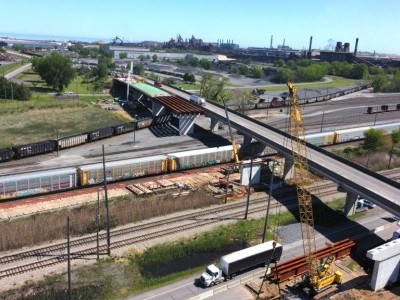With €28.3 million investment, Kaunas eyes becoming an international inland waterways port
Dec 07, 2020Lithuania’s second-largest city Kaunas is gradually becoming one of the most important transport nodes in the Baltic region. Due to the recently inaugurated Kaunas Intermodal Terminal, which has connected Lithuania to the European standard gauge rail network, the Kaunas – Polish-Lithuanian border cargo route will see 1.8 million tonnes of cargo in 2025. In the same year, the Polish border – Kaunas leg of the Via Baltica will be upgraded to 4 lanes, and the increased speed limit will help quicken transit of goods. With rail and road being covered, the city will also benefit from the recently approved €28.3 million project which will turn River Nemunas fully navigable by cargo barges.
A renewed transport artery
The modernization project of waterway E41 (which is part of the European TEN-T network, North Sea-Baltic Corridor) will have 500 to 700 levees installed or renovated in River Nemunas from Kaunas to the Nemunas Delta, where cargo barges reach the Curonian Lagoon and, subsequently, the seaport of Klaipėda. The upgraded levee system will allow the Lithuanian Inland Waterways Authority (LIWA) to ensure navigability or River Nemunas during the navigation season. According to LIWA, Nemunas, once a vital transport artery, has not seen an infrastructure project of this scope in almost 100 years.
“Already being the first major stop on the Via Baltica north of Poland and sporting one of three multimodal terminals to form the backbone of Rail Baltica’s cargo operations, Kaunas is in a privileged position, when it comes to logistics. Once Nemunas becomes fully navigable again, we’ll be able to offer manufacturers and transport companies an additional cost-effective and sustainable way of shipping raw materials and goods,” – states Andrius Veršinskas, Head of Business Division at Kaunas IN, the city’s development agency.
After the modernization project is implemented, it will take a barge with 1,000-2,000 tons of cargo 1-1.5 days to reach the Klaipėda seaport downstream. Upstream travel time is around 12 hours longer.
According to preliminary calculations done by the Lithuanian Inland Waterways Authority (LIWA) based on a survey of transport companies, in 2024, when the project is implemented, 357.5K tonnes of cargo will be handled, and later on increased to 427.5k tonnes per year. And, as waterways have fewer limitations in terms of capacity than other modes of transport, the potential volume of cargo shipped via the soon established water route might reach 10 million tonnes per year.
“A symbolic start happened in April 2019, when the very first cargo barge in the 30 years after Lithuania regained independence, reached the international Marvelė river port in Kaunas. The port infrastructure will be able to handle more than 1.2 million tonnes of cargo per navigation season, which exceeds 200 days,” – Vladimiras Vinokurovas, General Director at the Lithuanian Inland Waterways Authority says.
Among other things, waterway E41 will help Lithuania decrease overall pollution. As much as 17 tonnes of exhaust CO2 could be eliminated for every 1000 tonnes of cargo shipped the entire length of the waterway (300 km), compared to the same volume of cargo shipped by land. According to the European Commission, the energy consumption of inland waterway transport per ton-kilometre of transported goods is approximately 17% that of road transportation and 50% that of rail transportation.
Joining forces with rail and road
Another good example of Kaunas’ growing significance to the region’s transport sector is the Kaunas Intermodal Terminal (KIT). In October 2020, the terminal was directly linked to the European rail network, making the city the easternmost point where 1520 mm gauge and European standard gauge networks meet. The majority of freight trains travelling down the Rail Baltica line will be passing through this node. The cargo line will be seeing 62 trains per day running at a speed of 120 km/h in 2036. According to the Rail Baltica Global Project Cost-Benefit Analysis conducted by E&Y, the base case scenario will see 1.8 million tonnes pass between Kaunas and the Lithuanian-Polish border in 2025, the number increasing up to 14.9 million tonnes in 2035.
In addition to serving as an essential railroad node, Kaunas is a vital connecting point for cargo travelling on both roads and railways on the East-West (IX) and North-South (I) transport corridors. The 4-lane A1 highway, passing through Kaunas, connects Klaipėda (the northernmost warm-water port on the Baltic Sea) with Vilnius, and subsequently - Minsk. The 2-lane A6 highway connects it to the Latvian city of Daugavpils, and major cities in Russia down the line. Kaunas is also the first significant stop on the Via Baltica north of Poland. Half of the 80 kilometre-long Poland-Kaunas stretch has already been upgraded from 2 to 4 lanes, with a total of €156 million already invested in the project. The rest of the segment will be upgraded by 2025.
Similar Stories

Jeffersonville port delivers record road salt shipments to Greater Louisville area during recent winter storms
View ArticleNC Ports Notice: Holiday Schedule Notice Martin Luther King Jr. Day
The Port of Wilmington Container Gate (South Gate) and the Charlotte Inland Port (CIP) will operate on a reduced schedule on Monday, January 20: 8 AM-12 PM and 1 PM-5…
View Article
Port of Long Beach’s Cordero hails ‘Green Port’ achievements
View Article
Port of San Diego accepts $5 million grant from the San Diego County Air Pollution Control District for clean air project
View Article
Adriatic Gate Container Terminal welcomes Bora Med Service
View Article
Savannah gets India cargo to market up to eight days faster
View ArticleGet the most up-to-date trending news!
SubscribeIndustry updates and weekly newsletter direct to your inbox!





